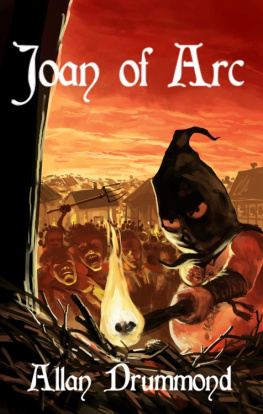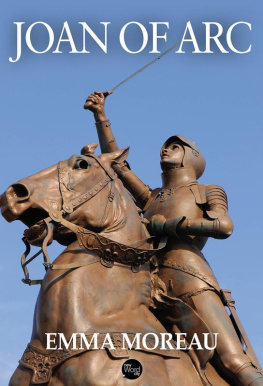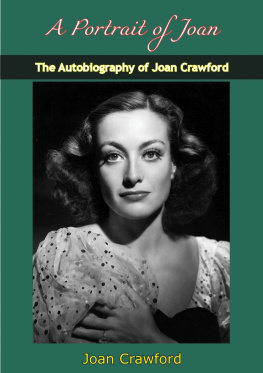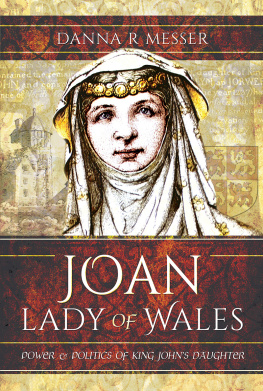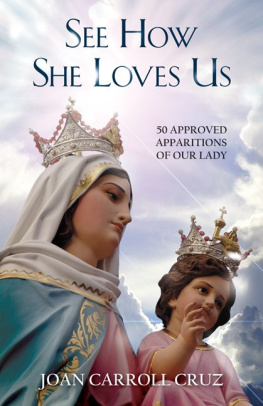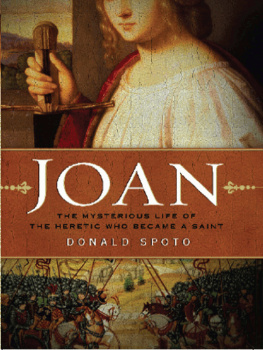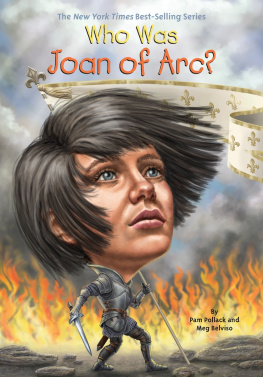
The Saint
Charles VII finally defeated the English and gained control of his kingdom in 1452, some twenty years after Joans death. But three years earlier, confident of victory, he had already taken steps to restore Joans reputation. He owed it to Joan. Her inspiration had led to the first setbacks that the English had suffered during the Hundred Years War, so her name was indelibly linked with that of Charles. He had to prove that she wasnt a witch! Guillame Bouill was asked to investigate the trial which condemned Joan to death.
Cauchon was dead, but many of the panel of judges were still alive. Its no surprise that none of them wanted to take responsibility for the Maids death. Inevitably, the Trial of Rehabilitation would find in favour of Joan.
The official verdict was that the original trial was invalid, that the judges were biased and that joan was an innocent, faithful and prayerful daughter of the Church.
Joans mum, who was still alive, was delighted.
Yet it wasnt until 1869 that real efforts were made to have Joan declared a saint. The process began with a speech by the Bishop of Orleans and ended with the declaration of her sanctity by Pope Benedict XV in May, 1920.
Joan wasnt declared a saint because she claimed to have visions and to hear voices: that was considered to be part of her personal prayer life and not something that the rest of us can really know about.
She wasnt considered to be a martyr for, technically, she didnt die for her faith. She did die unjustly. She was a prayerful young girl who saw the suffering that the endless war was causing. She was willing to urge on Charless forces in a just cause, though she never killed anyone herself. She was a compassionate woman whose own suffering reflected the unjust sufferings of Christ himself.
In 1920, the French had just been through the horrors of the First World War. The memory of Joan was once again a sign of hope for a country that was in need of such a sign.
National Library of Australia Cataloguing-in-Publication entry:
Creator: Drummond, Allan, author.
Title: Joan of Arc / Allan Drummond ; Milan Ristic.
ISBN: 9781925280692 (ebook)
Target Audience: For young adults.
Subjects: Joan, of Arc, Saint, 1412-1431
Christian saints--France--Biography.
France--History--Charles VII, 1422-1461.
Other Creators/Contributors: Ristic, Milan, author.
Dewey Number: 944.026092

Prophecy
Robert de Baudricourt was in command of the defences of the town of Vaucouleurs. He was a good, rough soldier, and loyal to his cause. A man among men. So when an eighteen year old girl in a patched red dress appeared before him, he became quite irritated.
She demanded to be taken to the heir to the throne, whom the French called the Dauphin.
She didnt ask.
She demanded.
She told Baudricourt that she would take command of a force to relieve Orleans which was besieged by the English enemy. She intended to lead the Dauphin, Charles, to Rheims, where he would be crowned.
And why in Gods name should I take any notice of you, little girl? de Baudricourt thundered.
Because I come from God! My voices have told me that you will take me to the king, she calmly replied.
Voices? boomed the leathery voice of the man of steel.
They speak to me all the time. St Catherine, St Margaret and St Michael too. Together we will save France.
Will someone show this wench across the drawbridge? he bellowed. Take her home to her father and tell him to give a good talking to. Get her out! Go! This is no place for a woman. Get out of here!
The year was 1428.
The country was France.
It was the time of the Hundred Years War, a time of awful suffering for the people of a country which had lost battle after battle to the English invaders. It was a time when soldiers and raiders stole and destroyed crops, and drove off animals to feed themselves. It was a time when Charles VI had died and his son, Charles VII, couldnt get to Rheims to be crowned because the English, and even many Frenchmen, headed by the Duke of Burgundy, wouldnt let him near the city where the kings of France were always crowned. It was a time when Paris itself would have nothing to do with the heir to the throne. It was a time when the kings advisers fought with one another. It was a time when the prices of everything kept rising above everyones ability to pay. It was a time when the calamity of the Great Plague was still part of everyones stories and memories. It was a time when many people lost their faith in God.
But others believed in the prophecy that salvation was near; that France would be freed, and that victory would be won under the banner of an innocent young girl.
A virgin.
The belief was chanted by drunken men in taverns. Holy women whispered it to one another after Mass. The prophecy was believed to have come from impressive sources. The legendary Merlin was quoted as saying:
A virgin will descend on the back of the bowmen and protect the lilies with her shadow.
The English were renowned for their longbows.
The lily was the symbol of France.

Voices and Visions
Joan grew up in the little village of Domrmy, in Lorraine, which is a part of France.
Her father was important enough. He and some of the other leaders of the village organised the rental of an abandoned castle near the town, so that the villagers could drive their animals there for shelter when raiding parties came through. The bells of the church of St Rmy were rung as an alarm.
When Joan was thirteen, a raid surprised the town and its livestock, and much of the furniture and household goods were carried off. She had first hand experience of the suffering of the French people throughout the war zone.
Joans mother was probably more religious than her father. It was from her that Joan learned about her faith, especially about the Virgin Mary, to whose shrine at Le Puy Madame DArc had made a pilgrimage. Le Puy stood for a life of prayer and simplicity, very much like the spiritual life that Joan practised throughout her short life.
It was said that St Dominic had begun the devotion of the Rosary at Le Puy. Charles VII had visited the place himself as had many others, rich and poor, to demonstrate their devotion to the Virgin Mother of God.
It was probably from her mother too, that Joan heard about two other virgins, St Catherine and St Margaret. St Catherine was tortured and killed many centuries earlier by the Emperor Maxentius because she would not do homage to his gods.
Have you heard of a spinning firecracker called a Catherine Wheel? The original Catherine Wheel was one which had sharp knives set into it, and it was this which was used to torture young Catherine. She is also said to have debated with fifty scholars, hand-picked by Maxentius, on whether her God or his was the better.
Maxentius killed them, one by one, as she defeated them!
The image of a young girl, with only her wits to defend her, is similar to the one we shall see at the end of Joans life. And the story of Catherine obviously made an impression on the dArc family, for Joan had a sister named after the saint.
Next page
